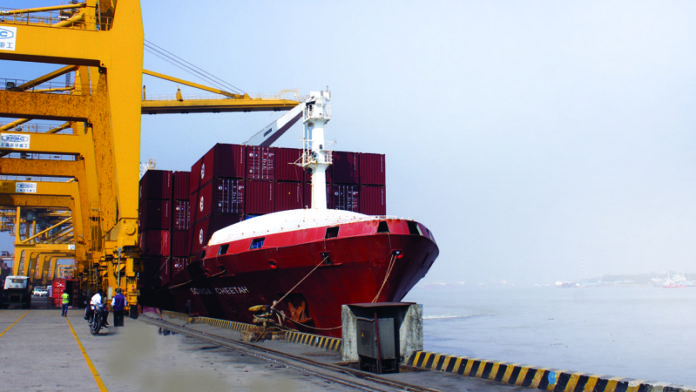On 8 February 2022, the MV Songa Cheetah sailed directly from Chittagong Port to Italy carrying 952 TEU containers of readymade garments for export. Although on a small scale, this direct freight service ushered in a new era in Bangladesh’s maritime transport sector. Many believe, the sector moved a step closer to achieving maritime trade self-sufficiency.
Bangladesh’s economy is in the process of transitioning from a least developed to a developing one. While policymakers are concerned about Bangladesh’s possible hurdles in foreign trade following the transition, this historic freight service has brought a feeling of confidence. Although the direct freight started with Italy, it will soon spread to other European countries, and even beyond Europe. The more we can solidify our position in and with Europe as a favourable export market for Bangladesh, the stronger our economic basis would be.
History speaks for itself
The Indian subcontinent and Bengal have a long history of maritime trade relations with Europe. In ancient and medieval times, several maritime routes were used to transport commercial goods between Europe and the Indian subcontinent. One route is from Venice, Italy, to Alexandria, Egypt, via the Mediterranean Sea, and then to Bombay (now Mumbai) on India’s west coast via the Red Sea. It should be mentioned that there was no Suez Canal at the time, therefore ships couldn’t sail directly on this route.
Another route was from Genoa, Italy, via the Mediterranean to Constantinople (modern-day Istanbul), and then via the Black Sea, the Tigris-Euphrates River and the Persian Gulf to the Indian Ocean. Another option for getting to India from Constantinople was to take the Black Sea-Caspian Sea-Amu Darya River-Indus River route.
However, those ancient trade routes were blocked when the Turks captured Constantinople and the East-Mediterranean coast in 1453. Then came the need to find alternate routes to keep the Indian peninsula connected to Europe, which led to Vasco da Gama’s discovery. The route travels from the port of Lisbon in Portugal, crosses past Africa’s Cape of Good Hope, and ends in the port of Calicut in southern India. On this journey, however, the ships had to cross the vast Atlantic and Indian Oceans. The Suez Canal, which was built 150 years ago, eventually provided a solution to this complication.
While direct shipping between Europe and the Indian subcontinent existed in ancient and mediaeval times, it is no longer a tough or impossible task. All we have to do now is a plan and determine whether or not it will be more profitable. Profit should not be determined just based on immediate numbers in this scenario. But it’s also about ensuring a long-term market.
Containers are shipped directly to Europe
Bangladesh has traditionally been a leader in garment exports because of its low labour costs and skilled workforce. However, in order to keep ahead of the competition in the world market, items must be delivered to international buyers as fast as possible. This necessitates long-distance direct freight service. The recent unnatural surge in freight fares during COVID-19, as well as the uncertainty caused in goods shipment due to bottlenecks in transhipment ports, have allowed that opportunity, albeit to a lesser level.
On 23 December, for the first time since the beginning of container transport in 1977, direct freight started between Italy and Chittagong with 952 TEU containers. On the first voyage, empty containers were carried from Italy, and when the testings were satisfactory, the containers were exported. Following this, a ship named MV Songa Cheetah set sail for Italy, a country 6,500 nautical miles away from Chittagong.
The ship sailed through the Karnaphuli River and travelled close to Hambantota Port in Sri Lanka, passing through the Bay of Bengal. It then cruised across the Arabian Sea, Indian Ocean, Gulf of Aden, Red Sea, Suez Canal, and the Mediterranean Sea to berth in an Italian port, Ravenna.
What motivates this initiative?
It usually takes 24 to 26 days to deliver goods from Bangladesh to Europe by transshipping to the ports of Singapore or Sri Lanka. But, the delivery may take more than 30 to 35 days due to booking delays on large ships in Singapore or Sri Lanka. The Chittagong-Italy direct shipping service, on the other hand, is lowering the time it takes for goods to be exported from Bangladesh to Italy. According to experts in Bangladesh’s ready-made garments sector, the service will take at least a week or two less time than Vietnam’s shipment to Italy.
The importance of launching this service has been felt even more amid the COVID-19. Especially during last year’s congestion, when containers full of ready-made garments heading for Europe had to spend several days in the transhipment hubs of Singapore and Sri Lanka. Because there was no place for containers and the large ship was already hauling Vietnamese and Chinese containers, no one knew when the container on the large ship would be loaded. As a result, fares have increased 5 to 10 times over normal.
Foreign buyers’ freight forwarders receive goods at private Bangladeshi depots, which they then transport to their respective nations on their own dime. Because transhipment ports are used in the case of importing from Bangladesh, European buyers must spend more time and money to receive goods from Chittagong.
As a corollary, Italian buyers who are releasing goods from Chittagong are experiencing some difficulties. However, after more than six months of suffering of the Italian buyers for the congestion in transhipment ports, RifLine Worldwide Logistics, a freight forwarding company from Italy, came forward with a solution. RifLine planned to send ships to Chittagong Port for direct container shipping and sought approval plus help from the Chittagong Port Authority. After reviewing the broader context, the chairman of the Chittagong Port Authority approved the start of the procedure and directed to give priority to provide all sorts of port facilities. Kalypso Compagnia di Navigazione SPA, a subsidiary of Reef Line, then launched the direct freight service.
According to RifLine representatives in Bangladesh, this is not a one-time stop because the ship will unload the container in Ravenna, Italy, and then return to Chittagong to ship the export goods. This initiative expands Bangladesh’s export opportunities by allowing Italian buyers to receive the goods for 30% less cost and in less than a week or two.
At present, the transport of a 40 feet long container from Chittagong Port to Europe via Singapore or Colombo ports costs around USD 14,000 to USD 15,000, whereas the newly launched direct shipping service costs USD 10,000.
Prospects
There was a period for Bangladesh when shipping goods by transhipment was more cost-effective than sailing long distances with a small number of goods in small vessels. However, due to the unavailability of large ships, abnormal increase in freight charges as well as congestions at transhipment ports, it is now considered cost-effective to transport container goods directly to Italy in small vessels. If freight costs are decreased to USD 2,500-USD 3,000 per container (40 feet), the scenario may change. However, the rate is not returning to normal overnight, as multinational corporations have hinted.
This hike in freight charges isn’t going to last forever. Will there be direct shipping between Europe and Bangladesh once things have returned to normal? In order to survive in such a situation, industry analysts say the number of ships must be increased, and larger ships must be added. If the new route becomes popular, many major shipping lines may step ahead.
Bangladeshi traders say that with the opening of a deep seaport at Matarbari in Cox’s Bazar, it will be possible to transport containers directly to Europe and the United States on large ships. They’ll have to wait a few more years for this to happen.

The goal is to cover all of Europe, beginning with Italy
Bangladesh’s seventh most important export destination is Italy. During the fiscal year 2020-21, the country exported a total of USD 1.3 billion to Italy, with readymade clothes accounting for 95% of the total. Simultaneously, products worth USD 436.9 million were imported from Italy, with capital equipment accounting for half of the total.
European markets account for more than half of Bangladesh’s overall exports. Readymade garments are at the top of the list of these export products (90% of the total exports). Apart from that, leather, jute, and tea are also sent to Europe in large quantities. It should be noted that 300,000 TEU containers were shipped to Europe from the total of 729,000 TEU containers exported through Chittagong Port last year.
Time for plans
Bangladesh will be officially upgraded from Least Developed Country (LDC) to the Developing Country category in 2026. Currently, the EU’s Everything but Arms (EBA) scheme provides favourable GSP benefits to 98% of the country’s exports. However, there is much conjecture as to whether this advantage will remain in the sphere of commerce after Bangladesh’s transformation into a developing country, or what problems it will encounter.
Bangladesh, on the other hand, has negotiated a temporary solution to the matter with the EU. Even after the transition, the European Union has agreed to extend duty-free trade for three years, until 2029. This is excellent news for Bangladesh, as it will help to ensure that the country’s post-transition trade runs smoothly. But what happens when this time span comes to an end? Now is the time to get ready.
Backward linkage industry deficits are a major impediment to Bangladesh’s industrialised trade, but the country is on the mend. Because numerous other Asian countries are posing a threat to the country’s export volume, it has no choice but to strengthen its position in the backward linkage industry to meet the challenge.
Not just in terms of production, but also in terms of timely delivery of items to customers, if the country fails it will lag behind its competitors. It is true that in the absence of a preferential trade agreement, European purchasers may choose to source their goods from another nation that they consider more convenient.
In terms of competitors, Vietnam has posed a serious challenge to Bangladesh in the readymade garments sector in recent years. Bangladesh currently has duty-free access to EU exports thanks to the GSP, and Vietnam has similar advantages according to the EU-Vietnam Free Trade Agreement (EVFTA), which was signed in early 2020 for 10 years. In other words, when Bangladesh’s GSP programme expires in 2029, Vietnam’s garment exports to the EU will continue to benefit for another year.
Direct freight to other markets
For a long time, Bangladesh has placed a strong emphasis on expanding its export market and diversifying its product portfolio, and as part of this, Bangladesh has signed a cooperation agreement with the Eurasian Economic Commission (EEC)-the executive body of the Eurasian Economic Union. This agreement will play a positive role in achieving duty-free and quota-free access to Bangladeshi products.
There are no customs borders between the five members of the Eurasian Economic Union (EEU) in Eastern Europe and Central Asia: Russia, Belarus, Kazakhstan, Armenia, and Kyrgyzstan, who are also members of the Commonwealth of Independent States (CIS). As a result, goods may be exported without difficulty from one country to another. All EEU member states have the same tariff rate and trade policy when it comes to overseas commerce.
Bangladeshi textiles, jute and jute goods, frozen fish, medicines, potatoes, and vegetables have great market potential in EEU nations, particularly in Russia. Ready-made garments, jute, frozen shrimp, and potatoes are currently shipped to Russia, but in small quantities compared to the market potential.
Despite the fact that there is no direct maritime route between the two nations, the United States is an established market for Bangladesh. However, Bangladesh’s competitors have made significant progress in terms of exports to the burgeoning US market, where retailers have expanded imports in response to rising consumer demand. According to entrepreneurs in Bangladesh’s ready-made garments industry, US buyers are making a large number of of orders.
Because of containers and large ship inadequacies, transporting containers to the United States now takes more time and costs more money; consequently, direct freight service may be a reasonable option in this scenario. The Philippines has recently sailed ships to the United States with export containers, recognising the importance of this. Bangladesh can also take such a step by examining and resolving a variety of relevant issues.

Conclusion
We recently celebrated the country’s Golden Jubilee of Independence, and the country’s maritime transportation industry witnessed a new chapter in its history. The establishment of a direct freight link with Europe, out of the dependent maritime transport system, has added a fresh feather to the crown of the country’s sovereignty and self-reliance.
Once war-torn independent Bangladesh was dubbed a “bottomless basket.” The country is now a role model for economic development, and such a direct freight programme was urgently needed to speed up that. Policymakers must now consider whether this service can be maintained and expanded to other regions in the future. Because now is the perfect time to build a long-term development strategy for Bangladesh.




